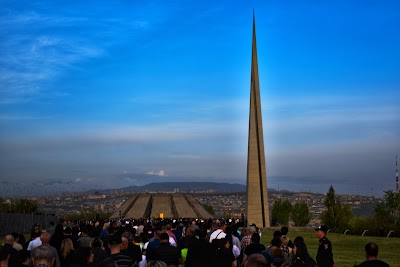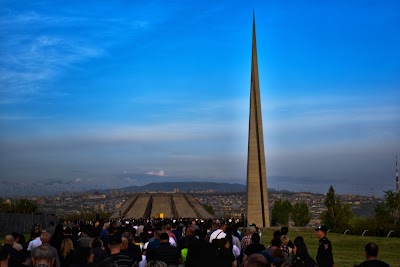Armenian Genocide Memorial (Ցեղասպանության զոհերի հուշահամալիր)
Overview
The Armenian Genocide Memorial, also known as Tsitsernakaberd, is one of the most poignant and historically significant sites in Yerevan, Armenia. Nestled on a tranquil hill overlooking the city, this memorial stands as a solemn tribute to the 1.5 million Armenians who lost their lives during the genocide orchestrated by the Ottoman Empire from 1915 to 1923. It serves not only as a place of remembrance but also as a powerful symbol of resilience and hope for future generations.
The memorial complex, officially opened in 1967, has become a major landmark for Armenians around the globe. The design of Tsitsernakaberd is both striking and deeply symbolic. As you approach the site, the first feature you’ll encounter is a towering 44-meter stele, reaching skyward, which symbolizes the national rebirth of the Armenian people. Adjacent to the stele is a circle of twelve basalt slabs that lean inward towards an eternal flame. These slabs represent the twelve provinces lost to modern-day Turkey, while the eternal flame serves as a poignant reminder of the lives lost and a call for eternal vigilance against such atrocities.
During your visit, be sure to explore the Memorial Wall, which stretches along the walkways inscribed with the names of towns and villages that were devastated during the genocide. This wall offers vital context for understanding the widespread impact of these horrific events.
Enhancing the memorial complex is the Armenian Genocide Museum-Institute, located nearby. Established in 1995, the museum provides an in-depth exploration of the historical, political, and social contexts surrounding the genocide. Through a series of compelling exhibits, including photographs, documents, and personal belongings of victims, visitors gain a deeper understanding of the tragic events and their lasting impact on the Armenian people.
The significance of the Armenian Genocide Memorial extends beyond its historical context. Each year on April 24th, thousands of Armenians and visitors from around the world pilgrimage to Tsitsernakaberd to commemorate Genocide Remembrance Day. The atmosphere is laden with solemnity and respect as people lay flowers around the eternal flame, creating a stunning sea of blossoms that symbolizes ongoing resilience and unity.
Interesting facts about Tsitsernakaberd include its name, which translates to "Swallow's Fortress" in Armenian, inspired by the site's location frequented by swallows during migration. Furthermore, the design of the stele and the arrangement of the basalt slabs were selected through a national competition, showcasing the collaborative effort to memorialize this tragic chapter of Armenian history.
Visiting the Armenian Genocide Memorial is not merely an educational journey; it's an emotionally moving experience that offers profound insights into the strength and enduring spirit of the Armenian people. The serene atmosphere, combined with the poignant memorials and informative museum, makes it a must-visit destination for anyone wishing to gain a deeper understanding of Armenia's history and the resilience of its people.
In summary, the Armenian Genocide Memorial in Yerevan stands as a testament to a nation's sorrow and its unyielding spirit. It serves as both a stark reminder of past atrocities and a beacon of hope for remembrance and the resolve to prevent such tragedies in the future. As you walk through the serene grounds, take in the thoughtful design, and pause at the eternal flame, you'll be part of an enduring act of remembrance that transcends time and geography.





